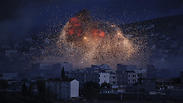
With the US-led assault on the Islamic State group, the world community is acting in Syria, but not in the Syrian civil war. When it comes to the issue that has undermined the region – the survival or fall of Syrian President Bashar Assad – there is still no plan.
And that means the West's goal to defeat the militants of IS may also be doomed to fail.
Syria's four-year civil war has killed hundreds of thousands and displaced millions in what began as a movement to replace Assad with a more democratic state. As the government's control weakened, militants rallying around Islamic slogans carved out a vast safe haven for themselves – recruiting, training and building fighting capacity. From Syria this year, they then struck deep into Iraq, with devastating effect, and now also threaten Lebanon.
Yet any concerted effort to oust Assad and restore stability to Syria does not appear to be on the horizon.
What emerges instead from the actions and words of Western policymakers is a glum resignation that there is nothing that can be done about Assad for now, and the fight is only with the Islamic State.
For many world leaders, allowing Assad to remain in control in Damascus appears to be the least-bad option.
That's striking, given the disaster he has overseen.
In an ideal world from a Western perspective, an army of "moderate" rebels headquartered in Istanbul would be an attractive choice to march into Syria and defeat both the Islamic State and the Syrian government. There are some rebels who are pro-Western and largely secular. Some even can be heard on Israeli radio stations promising a future of regional peace.
But upon inspection, these rebels are few, badly divided, and barely control the Free Syria Army, which purports to be their force on the ground and has little political support inside Syria. In reality, Free Syria Army fighters are often militant Islamists; in some cases, they have fought alongside al-Qaeda's branch in the country, the Nusra Front, or other jihadi groups. On the whole, they are far more motivated to fight against Assad than against the Islamic State militants.
So when Assad says that his is a fight against terrorists and radical Islamists, even to his staunchest critics the charge rings partly true.
All that is left is a disagreement over how Syria got there: European and other critics charge that Assad's brutal suppression of an initially peaceful and largely secular protest movement created the space for jihadis to move in. Assad claims they were there all along.

The current reality is that Syria has been divided into three or four parts. Assad controls most of a strip of land from Damascus to the Mediterranean coast, where his Alawites and other minorities are dominant. The Islamic State group controls the river corridor to Iraq and much of the northeast; the Kurdish minority controls a corner near the Turkish border; and an array of other rebel groups including the Free Syria Army and various Islamists control parts of the northwest.
Here are four possible ways the conflict could go:
A comprehensive political solution
Believe it or not, there is a peace process that could be revived. The so-called Geneva communique, a roadmap agreed on by major powers in June 2012, calls for the establishment of a transitional governing body for Syria. But the document is open for interpretation, and two rounds of peace talks between government and opposition representatives in Switzerland this year ended in failure. Assad then orchestrated a vote in government-held areas of Syria and claimed another seven-year term in office.
Stillborn as it seems, many still see this plan as the best framework for a settlement once the war runs out of steam. But for now it appears to be a non-starter. At best, it would take renewed heavy international pressure on Assad, including both carrots and sticks, to bring him back to the table.
Assad stays, Syria contracts
A complete military victory by Assad is highly unlikely. The Syrian army simply does not have the firepower or the manpower to reconquer all the territory lost to the rebels, and the Islamic State maintains a hold over much of the country. But Assad can claim success just by continuing to hang on to his power base in Damascus, Homs and the Alawite stronghold on the Syrian coast. This could go on for some time, and essentially change the definition of what is Syria.
The rebels regroup with Western help
Congress has already approved $500 million to train up to 5,000 Free Syria Army fighters. Some CIA-trained fighters have been gaining ground against Assad in southern Syria and in some places around Damascus.
Turkey and other US allies have proposed a no-fly zone inside Syrian territory, which could give pro-Western rebels the seeds of their own secure buffer within Syria. But the rebels would also have to be protected both from Assad and Islamic State fighters, and eventually defeat them both, which for now appears a remote possibility.
The world steps in
President Barack Obama has ruled out US boots on the ground, at least for now, and no other nation has offered troops for a military solution to the civil war. But that could change if the situation deteriorated.
An Islamic State takeover of Damascus might make the grade, or a truly dramatic uptick in casualties, or a collapse of government control in Lebanon. So would a doomsday scenario that's almost never discussed: Israel – armed with nuclear weapons, watching with horror, a stone's throw from Damascus – being somehow dragged into the fray.
















